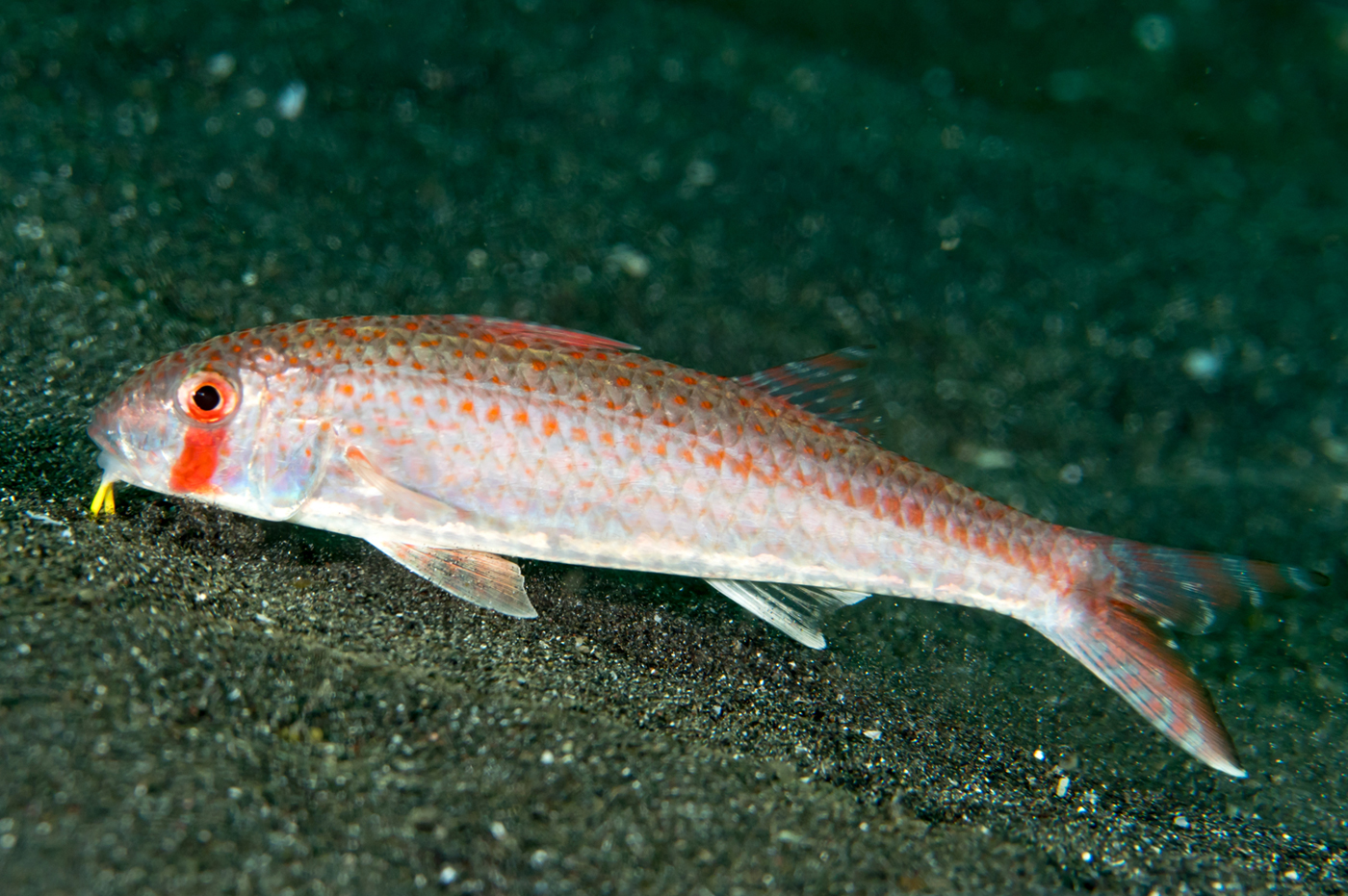- Classification
- ACTINOPTERYGII
- PERCIFORMES
- MULLIDAE
- Upeneus
- sundaicus
Ochreband Goatfish, Upeneus sundaicus (Bleeker 1855)
Other Names: Ochre-banded Goatfish

An Ochreband Goatfish, Upeneus sundaicus, in Lembeh Strait, Sulawesi, Indonesia, June 2018. Source: Rickard Zerpe / Flickr. License: CC BY Attribution
Summary:
A greyish goatfish becoming silvery on the sides and white below, with a broad red bar below the eye, yellow barbels, reddish-orange spots scattered along the back, an reddish to orange stripe or indistinct row of reddish to orange spots along the side behind the eye, 3-5 broad faint bars on the upper caudal-fin lobe, a broad reddish streak on the lower lobe with short narrower bars on the lower margin of the lobe.
Cite this page as:
Bray, D.J. 2020, Upeneus sundaicus in Fishes of Australia, accessed 06 Jul 2025, https://fishesofaustralia.net.au/home/species/600
Ochreband Goatfish, Upeneus sundaicus (Bleeker 1855)
More Info
|
Distribution |
Exmouth Gulf, Western Australia, to Shoalwater Bay, Queensland. Elsewhere the species occurs in the tropical, Indo-west Pacific. Inhabits inshore muddy and silty areas at depths to about 50 m. |
|
Features |
Dorsal fin VIII,9; Anal fin I, 7-8; Pectoral fin 13-14; Gill rakers 4-5 + 14-15 = 18-20; Lateral line scales 31-34; Body depth at first dorsal-fin origin 25-28% SL, at anal-fin origin 22-24% SL; caudal-peduncle depth 11-13% SL; maximum head depth 21-23% SL; head depth through eye 17-20% SL; head length 27-30%SL; orbit length 6.1-7.2% SL; upper jaw length 11-12% SL; barbel length 18-21% SL; caudal-fin length 26-29% SL; anal-fin height 16-18% SL; pelvic-fin length 20-23% SL; pectoral-fin length 21-23% SL; first dorsal-fin height 25-29% SL; second dorsal-fin height 16-18% SL. |
|
Colour |
Three to six weak, red or grey bars on upper caudal fin lobe (not retained on preserved fish); no bars on lower lobe, fully to partly covered with a reddish or greyish band (lost in preserved fish); a pale brown mid-lateral body stripe from behind eye to caudal-fin base (sometimes retained in preserved fish); no dark dorsal-fin tip; yellow barbels when fresh; body reddish or dark grey dorsally, whitish-rose ventrally; head with red or grey pigmentation at snout and above eyes (body may darken dorsally in preserved fish (Uiblein & Heemstra 2010). |
|
Fisheries |
taken in commercial trawls in parts of its range. |
|
Species Citation |
Upeneoides sundaicus Bleeker 1855, Natuurkundig Tijdschrift voor Nederlandsch Indië 8: 411. Type locality: Amboina (= Ambon, Indonesia) |
|
Author |
Bray, D.J. 2020 |
|
Resources |
Ochreband Goatfish, Upeneus sundaicus (Bleeker 1855)
References
Allen, G.R. 1997. Marine Fishes of Tropical Australia and South-east Asia. Perth : Western Australian Museum 292 pp. 106 pls.
Allen, G.R. & Erdmann, M.V. 2012. Reef fishes of the East Indies. Perth : Tropical Reef Research 3 vols, 1260 pp.
Allen, G.R. & Swainston, R. 1988. The Marine Fishes of North-Western Australia. A field guide for anglers and divers. Perth, WA : Western Australian Museum vi 201 pp., 70 pls.
Blaber, S.J.M., Brewer, D.T. & Harris, A.N. 1994. Distribution, biomass and community structure of demersal fishes of the Gulf of Carpentaria, Australia. Australian Journal of Marine and Freshwater Research 45(3): 375-396, figs 1-7
Bleeker, P. 1855. Zesde bijdrage tot de kennis der ichthyologische fauna van Amboina. Natuurkundig Tijdschrift voor Nederlandsch Indië 8: 391-434
Bleeker, P. 1864. Quatrième notice sur la faune ichthyologique de l'île de Bouro. Nederlandsch Tijdschrift voor de Dierkunde 2: 141-151
Gloerfelt-Tarp, T. & Kailola, P.J. 1984. Trawled Fishes of Southern Indonesia and Northwest Australia. Jakarta : Dir. Gen. Fish. (Indonesia), German Tech. Coop., Aust. Dev. Ass. Bur. 406 pp.
Kühlmorgen-Hille, G. 1974. Family Mullidae. 33 pp. 76 figs in Fischer, W. & Whitehead, P.J.P. (eds). FAO Species Identification Sheets for Fishing Purposes. Eastern Indian Ocean and Western Central Pacific. Fishing areas 57 and 71. Rome : FAO Vol. 3.
Larson, H.K., Williams, R.S. & Hammer, M.P. 2013. An annotated checklist of the fishes of the Northern Territory, Australia. Zootaxa 3696(1): 1-293
Randall, J.E. 2001. Mullidae. pp. 3175-3200 in Carpenter, K.E. & Niem, V.H. (eds). The Living Marine Resources of the Western Central Pacific. FAO Species Identification Guide for Fisheries Purposes. Rome : FAO Vol. 5 2791-3379 pp.
Russell, B.C. & Houston, W. 1989. Offshore fishes of the Arafura Sea. The Beagle, Records of the Museums and Art Galleries of the Northern Territory 6(1): 69-84
Sainsbury, K.J., Kailola, P.J. & Leyland, G.G. 1984. Continental Shelf Fishes of Northern and North-Western Australia. Canberra : Fisheries Information Service 375 pp. figs & pls.
Smith-Vaniz, W.F. & Williams, I. 2016. Upeneus sundaicus (errata version published in 2017). The IUCN Red List of Threatened Species 2016: e.T46086703A115394283. https://dx.doi.org/10.2305/IUCN.UK.2016-3.RLTS.T46086703A46664749.en. Downloaded on 24 August 2020.
Uiblein, F. & Heemstra, P.C. 2010. A taxonomic review of the western Indian Ocean goatfishes of the genus Upeneus (Family Mullidae), with descriptions of four new species. Smithiana, Publications in Aquatic Biodiversity, Bulletin 11: 35-71
Uiblein, F. & Heemstra, P.C. 2011. Description of a new goatfish species, Upeneus randalli n. sp. (Mullidae), from the Persian Gulf, with remarks and identification keys for the genus Upeneus. Scientia Marina 75(3): 585-594
Whitley, G.P. 1955. Taxonomic notes on fishes. Proceedings of the Royal Zoological Society of New South Wales 1953–54: 44-57 figs 1-8 (described as Pennon armatoides) See ref at BHL




